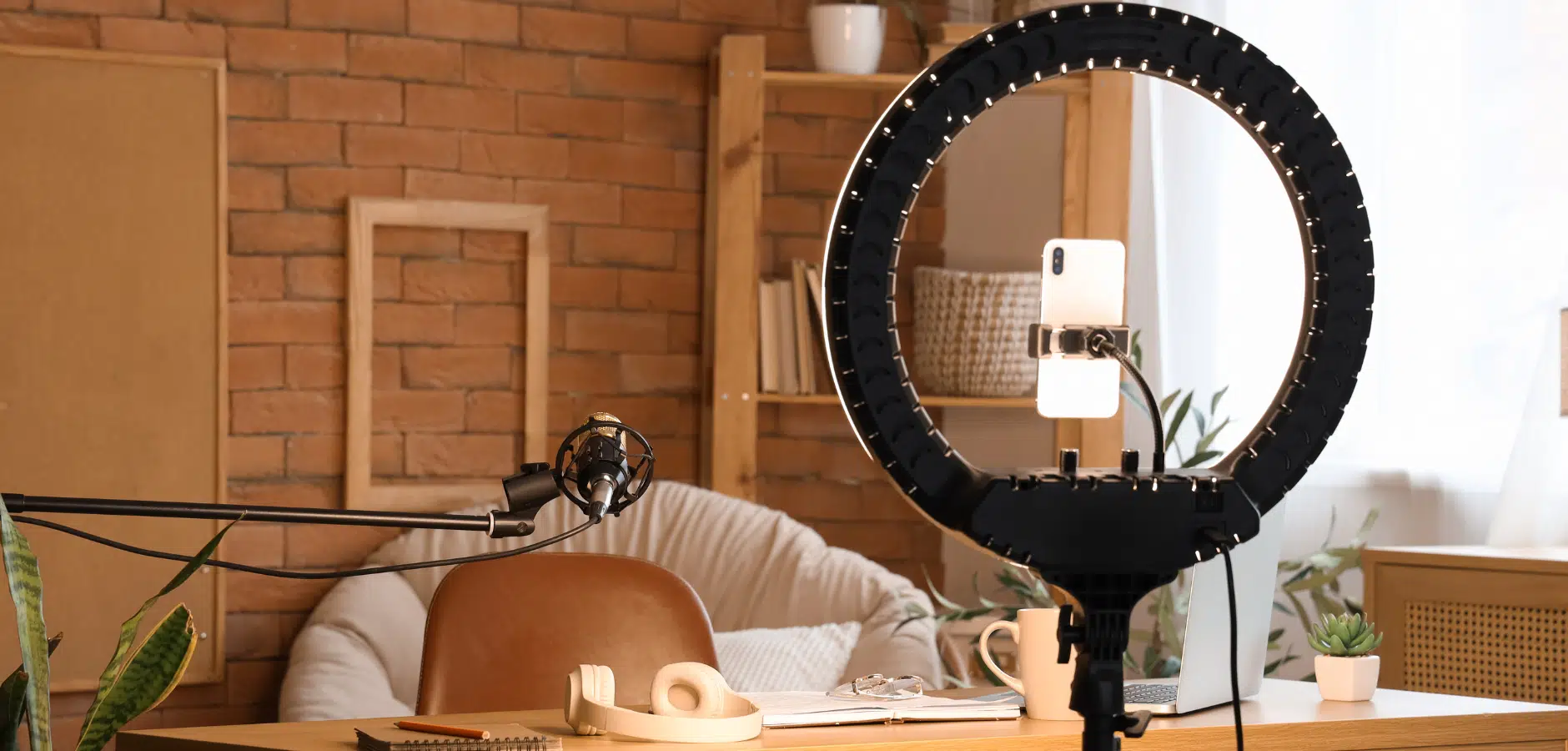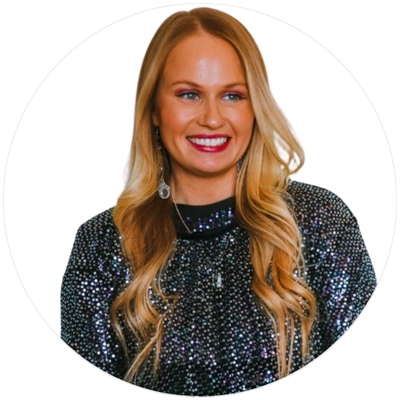Digital ad spend returned to double-digit growth (+10.7 percent) in 2024 while traditional TV advertising shows marginal 0.6 percent growth, highlighting the ongoing shift toward data-driven channels. Platform algorithm changes have squeezed organic reach, paid advertising costs keep climbing, and meanwhile, social platforms have become shopping destinations where over half of global users discover products through content creators.
The business case for change is getting stronger by the quarter. As attribution models become increasingly myopic and struggle with privacy regulations like GDPR, marketing mix models are making a comeback—offering the broader view that marketing leaders need to accurately measure creator return on investment (ROI) with the same precision as paid search. Meanwhile, your competitors are quietly shifting budgets toward these partnerships, making cost efficiency gains impossible to ignore.
Yet many brands are still approaching creator partnerships like it’s 2019. They throw money at awareness campaigns and hope something sticks. The disconnect is obvious: you’re treating one of the most powerful conversion channels like a brand awareness experiment.
Smart marketing leaders are already making the shift. As Jeff Melton, Senior Director of Global Creator Community at impact.com, puts it: “Creators are shrinking the path to purchase.” They’re turning what used to be a drawn-out customer journey into something much more direct and actionable.
This is what that looks like in practice: While your competitors are paying creators flat fees based on follower counts, you could be building performance-driven partnerships that actually move the revenue needle. According to Kristina Nolan, VP of Media Services at DMI Partners, “The storytelling aspect is crucial—creators provide more lasting value than traditional Meta ads because they can showcase brand differentiators in ways that few other media channels can.”
The timing matters. Early adopters are seeing real advantages before creator costs inevitably rise and the space gets more crowded.
In this deep dive, you’ll get:
- Practical frameworks for transitioning from awareness-focused to performance-driven creator partnerships
- Real ROI data and budget allocation strategies from brands already doing this successfully
- The compliance and tracking basics you need to avoid costly mistakes
- Step-by-step implementation guidance you can actually use
When creators work with affiliate programs, their content can deliver strong results for increasing conversions.
In this blog:
- Explore how brands can leverage creator partnerships to boost social commerce success.
- Gain insights from a panel of expert thought leaders.
- Learn how authentic content can become a scalable, high-value channel for conversions.
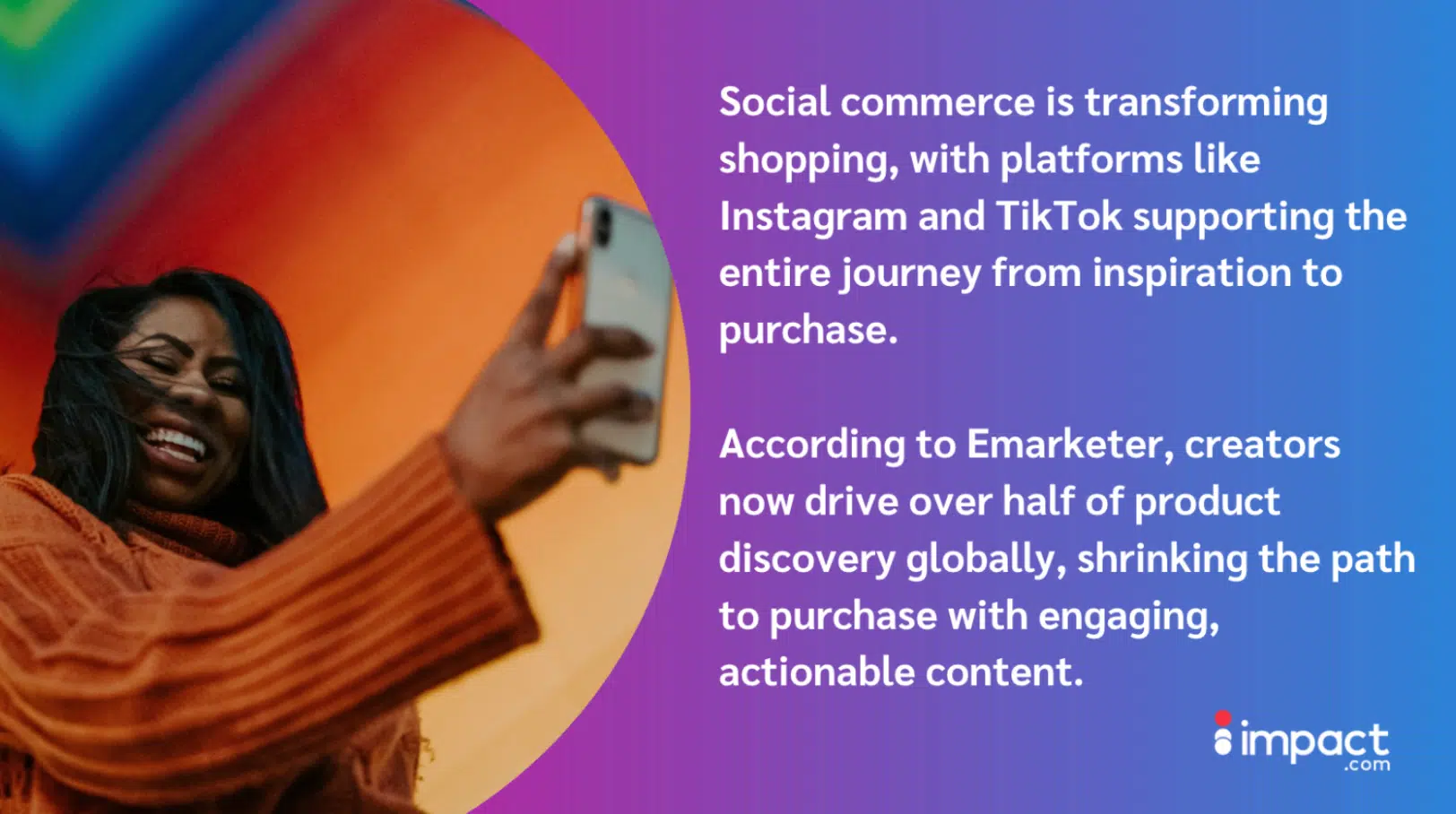
Why creators excel in driving social commerce and affiliate conversions
Creators thrive where traditional ads fall short. Their strong suit is building trust and sparking action. Their content feels personal, relatable, and real. This content is what today’s shoppers respond to.
Instead of a heavy sell, audiences feel like they’re getting a recommendation from a trusted friend. 60 percent of consumers say they trust creators who are relatable. This relatability turns passive views into engagement and then purchases, driving sales with creators.
When creators share genuine experiences with products and pair that content with affiliate links or in-platform shopping tools, they create a streamlined path to purchase. This is a core affiliate strategy without a hard sell. Instead, there’s authentic storytelling backed by direct, trackable results.
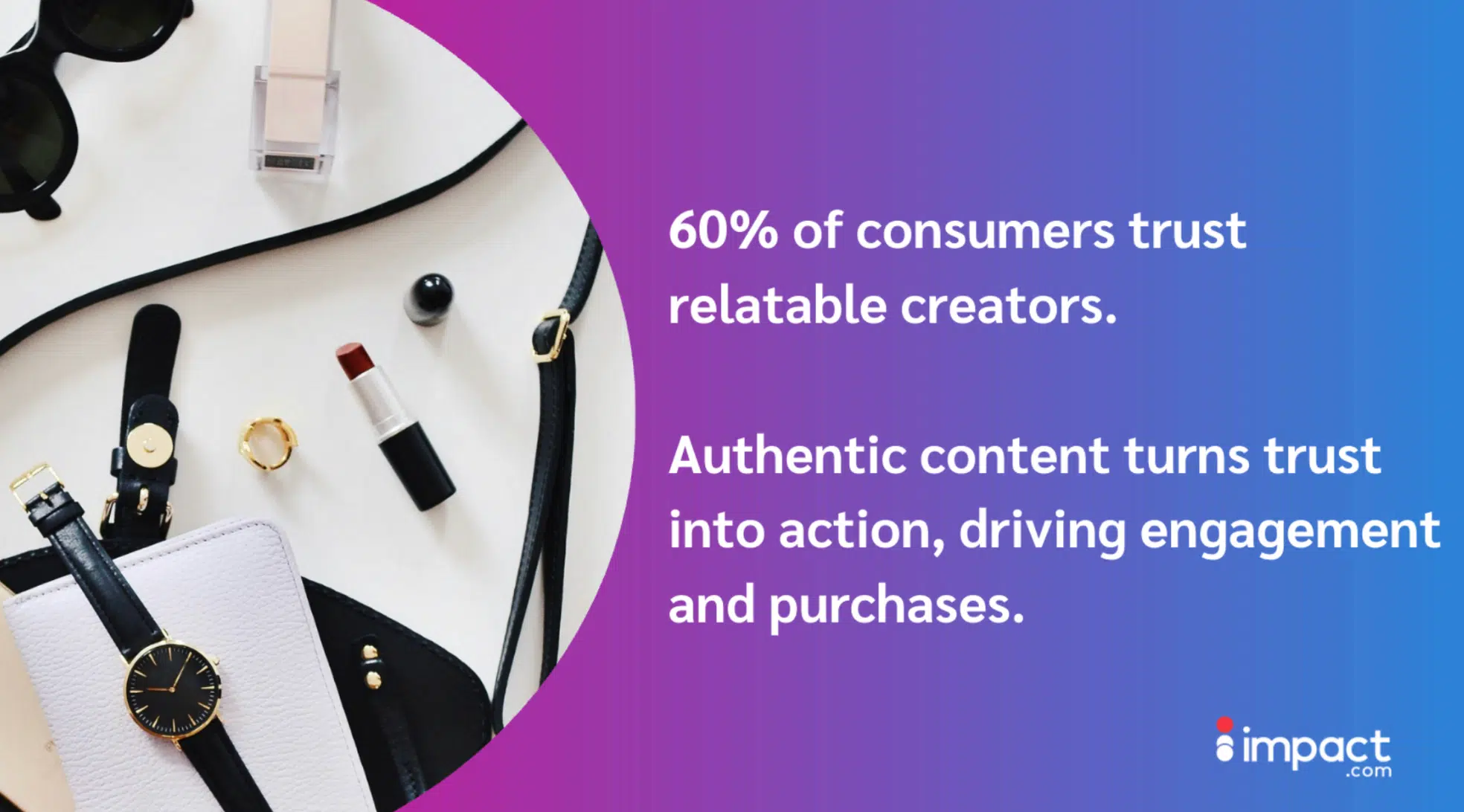
There’s no magic number of times a consumer needs to see a creator recommend a product before they buy. While repetition can help build familiarity, it’s not the only factor at play. How relevant the product is to the consumer’s needs, the timing of the recommendation, and most importantly, the level of trust they have in the creator all influence the decision-making process.
Context matters just as much as frequency. A single, well-timed recommendation from a trusted voice can have more impact than multiple mentions from someone the audience barely knows.
Here’s how creators drive conversions across platforms:
Trust: How creators drive buyer intent and affiliate conversions
Trust is the bridge between interest and action. It’s why 89 percent of consumers say they trust personal recommendations over any other channel. In the noisy world of digital marketing, consumer trust is hard-won, and creators are uniquely positioned to earn it.
When a creator shares a product they genuinely use, it doesn’t come across like an endorsement. Instead, it feels like a personal tip from someone you know. Unlike a faceless review or a highly produced ad, a creator’s recommendation is layered with personality, context, and authenticity.
The audience has seen them test, talk about, and integrate the product into their real life, often over weeks or months. That consistency builds credibility. This dynamic is why creators are such powerful drivers of affiliate conversions.
It’s often the “friend factor” at work. When someone you feel close to suggests a product, you’re far more inclined to try it than if you saw it on a billboard or in a generic commercial.
That layer of perceived closeness turns casual scrolling into real buyer intent. When a product feels personally endorsed by someone you trust, the decision to click “buy” feels easier, faster, and more confident.
Passionate content drives affiliate sales
Passion sells when it’s real.
The difference between “I’m obsessed with this” and “Hey guys, this is pretty cool” is everything. Audiences are drawn to genuine enthusiasm. When creators share products they love with energy and conviction, people take notice and often take action.
That kind of excitement feels more authentic and makes content more persuasive. It’s why some brands see sellouts within 24 hours of a creator’s post. Passion signals trust, urgency, and relevance, which are all key drivers of conversions.
Consistent posting keeps products top-of-mind
In affiliate marketing, visibility is everything. Conversions rarely happen after a single post, it’s the steady drumbeat of mentions over time that moves a product from “nice to know” to “must have” in a consumer’s mind. The most successful creators treat product promotion as an ongoing conversation, not a one-off announcement.
Consistent posting serves two purposes. The first is that it increases the likelihood that a follower will see the content at all (given ever-changing algorithms), and secondly, it reinforces the product’s relevance.
Caroline Hindman, Senior Manager of Creator Services at impact.com, sees the same pattern firsthand, noting that creators who understand the value of repetition often outperform those relying on single shout-outs. The more often a potential customer encounters the same item, especially in different contexts, the more familiar and trustworthy it becomes.
The key lies in execution. When creators truly love a product, they naturally integrate it into their Stories, Reels, livestreams, and posts.
But smart marketers know that not all formats work the same way—some drive clicks better than others. For example, Stories tend to convert better than Reels.
A well-planned, multi-format strategy keeps the product top-of-mind without risking overexposure. This approach turns consistent promotion into a trust-building habit, rather than just sales pitch.
Building a creator-centric affiliate strategy for social commerce
To drive real results from social commerce, brands need more than one-off influencer campaigns.
The best affiliate strategies focus on:
- Long-term creator partnerships
- Tiered, performance-based incentives
- Complete content funnels (from awareness to post-purchase support)
64 percent of consumers repeatedly purchase based on creator recommendations and reviews. So there’s never been a better time to design an affiliate program that puts creators and conversions at the center.
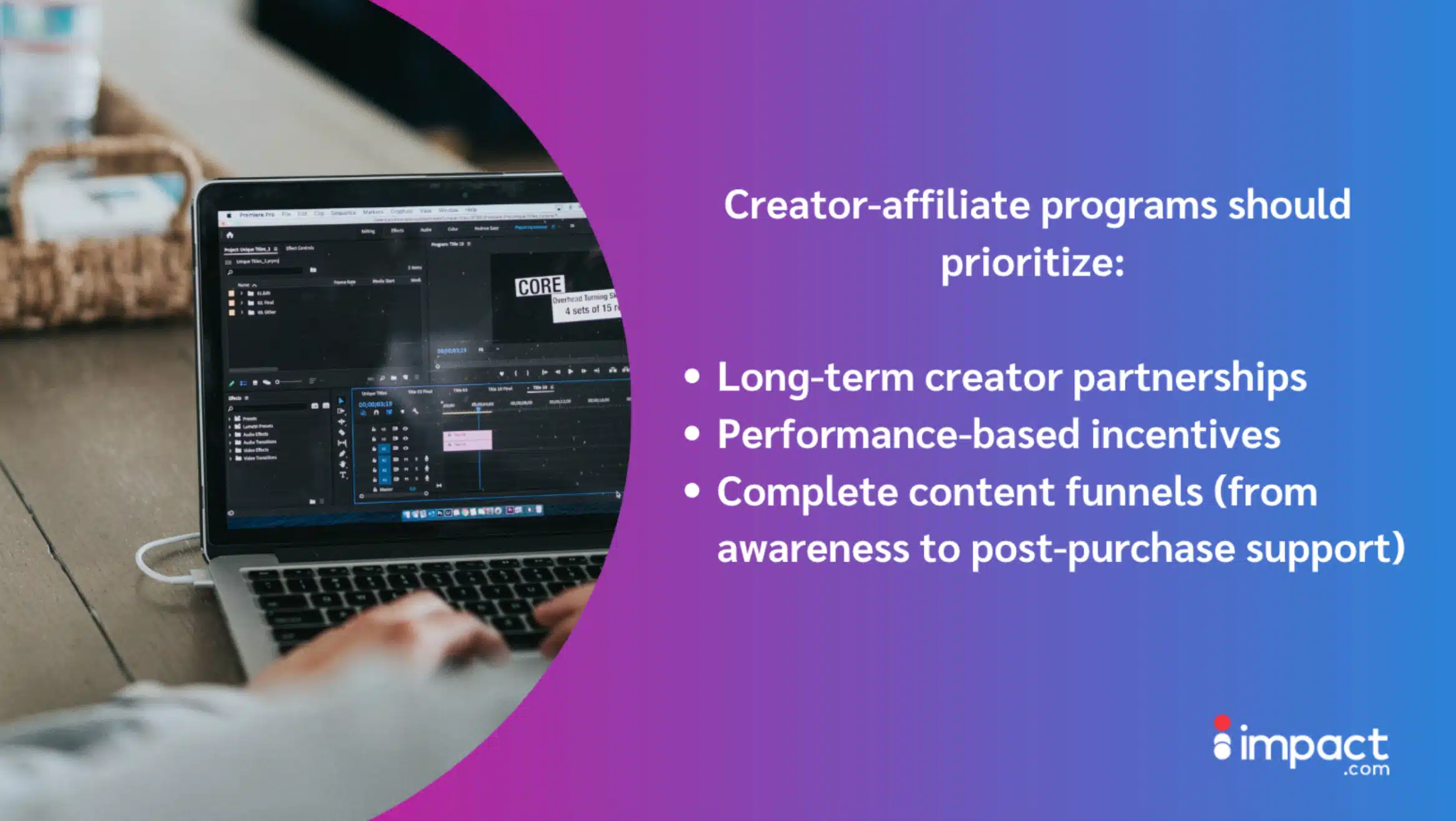
Engaging audiences: How affiliate-creators support the buyer’s journey at every stage
Creators guide audiences from first impression to final purchase. By tailoring their content to different stages of the buyer’s journey, they help brands drive action and awareness.
People often view influencer marketing as just a top-of-funnel marketing tactic. However, when you experiment with combinations of things like a strong call to action (CTA), affiliate links, and paid media, and other elements, it turns into a full-funnel strategy.
Creators can spark curiosity, nurture intent, and close the loop with an easy path to purchase.
Top of funnel content
Commission creators to create visually engaging content. This can include tutorials, unboxings, or hauls to spark interest. This approach is great for capturing attention and introducing the product in an entertaining way. It also works well for bottom-funnel strategies. By providing compelling and relatable content, it helps reinforce purchase decisions.
Entertainment is everything
The most effective content today grabs attention fast. An eye-catching Instagram Story can turn someone from unaware to ready to buy in less than 30 seconds. This happens when the content feels authentic, fun, and convincing.
Short-form video drives discovery
In-feed content like TikTok videos, Reels, and carousels work best for upper-funnel strategies, where the goal is reach and resonance.
Airbnb partner @sherryeatworld highlights a local coffee tour in San Francisco on Instagram. It feels more personal and focused on experience than on promotion. The creator captures the activity’s vibe and adds a relatable caption. This sparks intrigue and interest without pushing a hard sell.

Middle of funnel content
At this stage, the goal is to deepen engagement and move audiences from casual interest to serious consideration.
Commissioning user-generated content (UGC), encouraging in-depth reviews, and hosting live Q&As can give potential buyers the confidence they need.
On social, these formats turn a product from something distant into something tangible. It’s comparable to transforming a flat image into an experience that feels personal and immediate.
Make it natural
Some of the most effective creator content doesn’t read like a sponsored post at all. Instead, products are woven into posts that entertain, inform, or inspire. Taking a subtle approach draws audiences in, keeps engagement high, and often extends a post’s reach.
Provide real value
Educational and entertaining content builds trust and answers key questions. In fact, 53 percent of consumers follow influencers for expert advice or how-to content, which shows their desire to learn from creators.
Encourage creativity
A creator’s unique style is often their biggest asset, and the key to making promotional content resonate. The most impactful campaigns go beyond financial incentives, tapping into authentic creativity and a genuine desire to deliver value. When creators fully commit to a concept, their personality shines through. The result is content that drives results and strengthens their bond with the audience.
@sidehustlereview uses this YouTube video to explain how he monetizes his newsletter through affiliate links, paid ads, and subscriptions.
The episode mixes honesty—like sharing his real earnings and challenges—with useful education. It guides viewers through Beehiiv’s platform, actual ad offers, and performance metrics.
The content seamlessly incorporates affiliate links, making them feel authentic and informative. It’s an excellent example of mid-funnel creator content, effectively building trust and encouraging consideration without coming across as pushy.

Bottom of funnel content
At the final stage, the goal is simple. You want to drive action. Use tactics like time-limited discounts, special affiliate deals, and shoppable content. These can turn interest into sales.
Focus on conversion-ready platforms
Instagram Stories excel at driving purchases. They combine high engagement with the immediacy of clickable links. YouTube, on the other hand, often serves as a powerful bottom-funnel channel. Its viewers tend to be highly intentional; they actively search for specific products or solutions, so it’s a prime space for conversion-focused content.
Create urgency to convert
Passionate and convincing content is highly effective. When paired with a discount and a sense of urgency, it becomes even more powerful. Combining a compelling offer with a trusted recommendation is a proven way to achieve great results.
YouTube travel creator @takashiifromjapan teams up with online learning platform Preply in his “Why Did You Choose Korea Over Japan?” video. He gives viewers 50 percent off their first lesson using a special affiliate link. The video clearly mentions the offer and includes it in the description. This builds urgency and adds value for viewers eager to learn a new language.
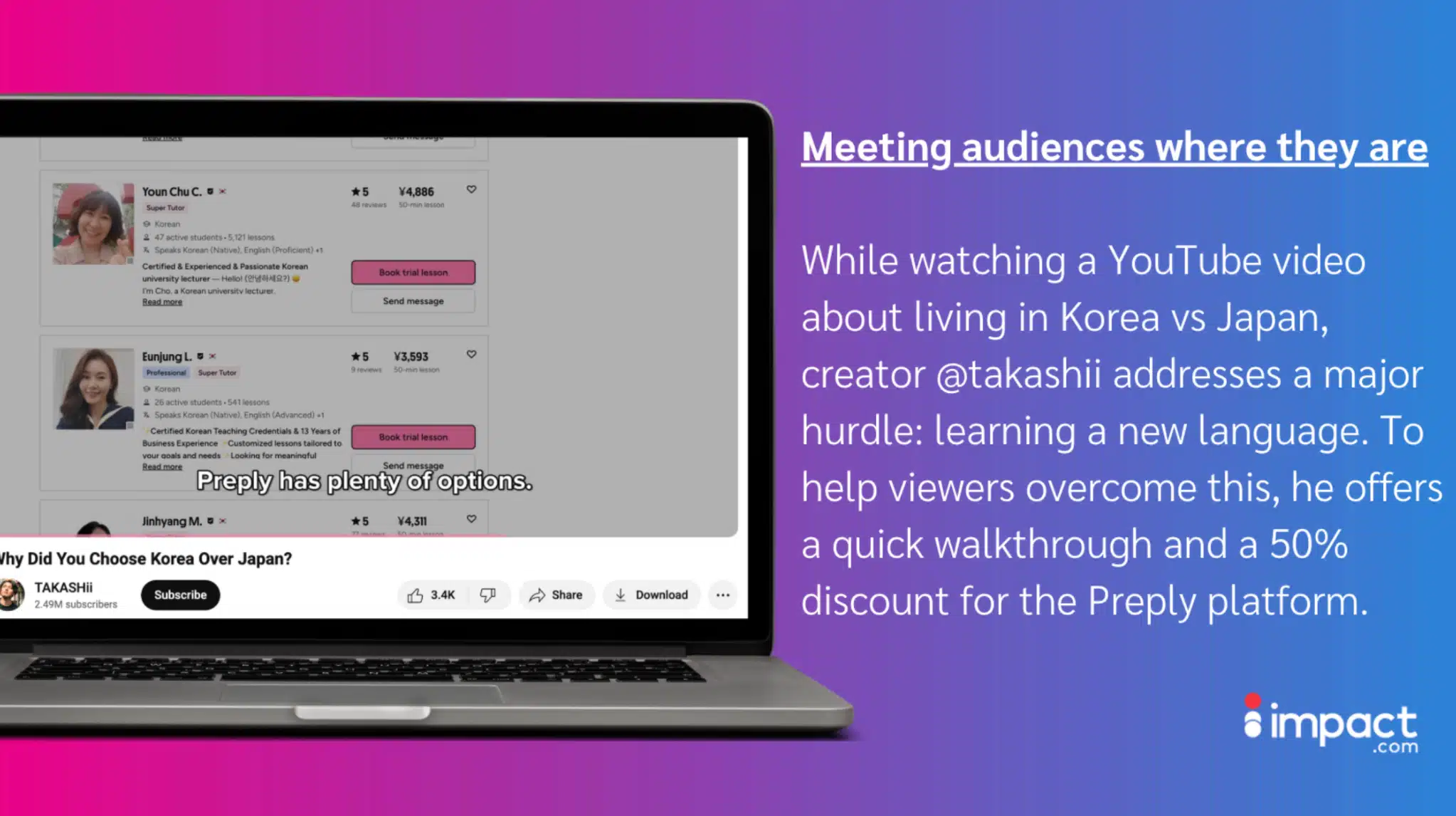
Since the content feels engaging and community-driven, the affiliate plug blends in naturally, making it more persuasive and likely to convert.
The partnership is a natural fit, connecting the experience of migrating to a new country with the necessity of learning a new language.
Selecting content creators with potential to boost affiliate ROI
Choosing the right creators is key to driving affiliate performance and boosting affiliate ROI. But that doesn’t always mean choosing the creator with the most followers.
Start with creators already talking about your brand
The easiest partnerships to build are with creators already posting about your products. They’ve proven a natural fit. They offer brand-content alignment, strong audience engagement, and performance metrics to review before committing. Built-in familiarity often leads to smoother collaborations and stronger results from day one.
Prioritize engagement and content quality
Focus on creators with a track record of producing high-quality content and generating strong engagement. Past performance in affiliate campaigns is another reliable indicator, conversion data matters more than likes.
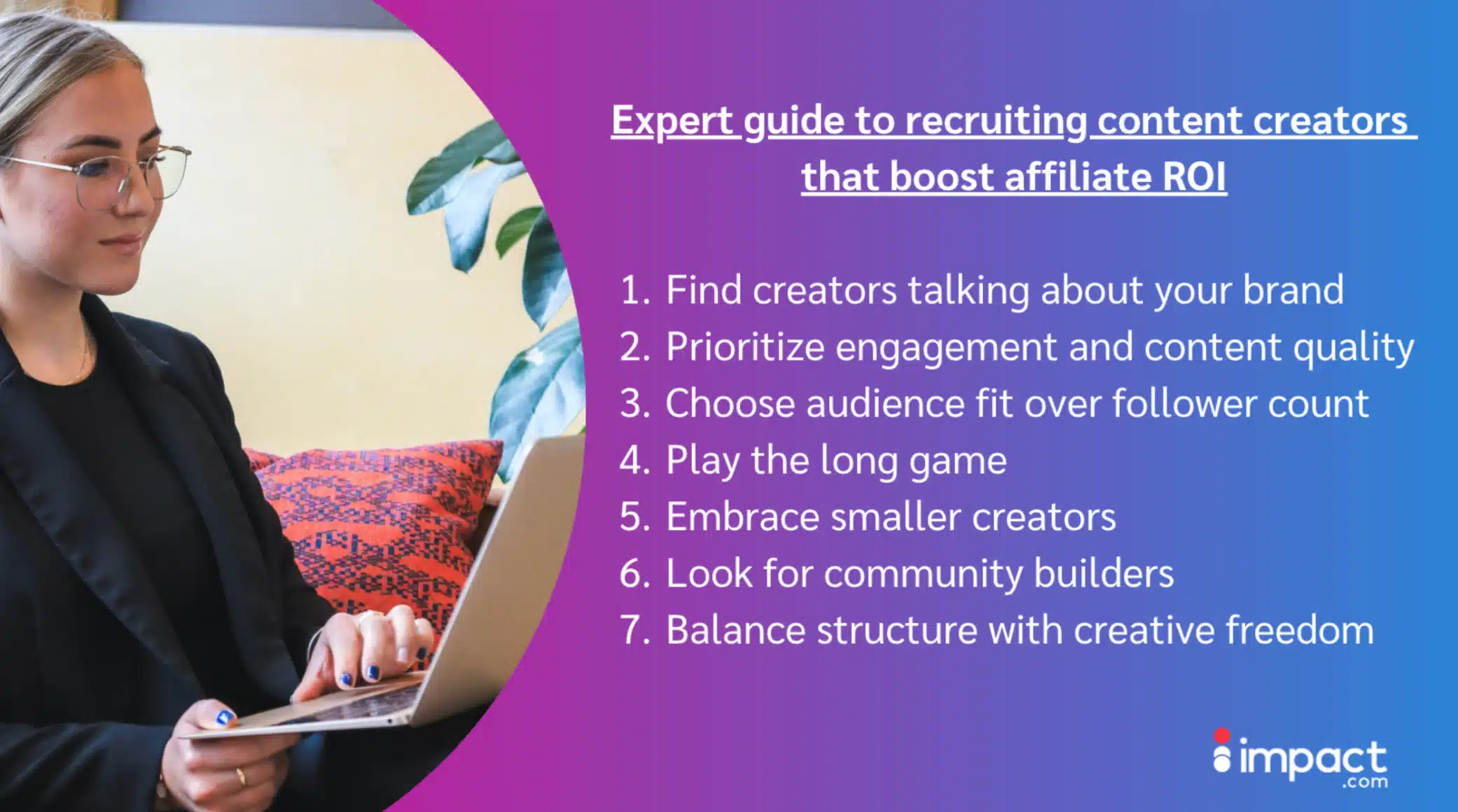
Audience fit is more important than follower count
Follower numbers are no longer the gold standard for measuring creator potential. With algorithm-driven delivery, a post can reach millions of people beyond a creator’s own audience, or barely register with their existing followers.
That’s why brands need to look past vanity metrics. Instead, focus on what really matters:
- Engagement quality
- Authenticity
- Proven conversion performance in past campaigns
Playing the long game
Affiliate success doesn’t happen overnight, and the best creators know it.
Conversions often come through repetition. That’s why it’s critical to partner with creators who understand the value of consistency and long-term commitment.
Don’t overlook smaller creators
Scale is more important than star power. Micro- and nano-creators often deliver higher engagement and better conversions. This is because they have built trust with niche communities. Their accessibility and relatability make them the most popular influencer tier.
Close to half of audiences resonate with micro-creators. Small and mid-sized brands get great results from this group. Micro-creator posts generate 2.4 to 6.7 times more engagement than the brand’s own content.
Look for community builders
These smaller creators aren’t just content machines, they’re fostering real relationships. Many are open to cost per action (CPA) or hybrid payout models, making them both cost-effective and performance-driven partners.
Balance structure with creative freedom
The best brand–creator partnerships mix clear guidance with room to experiment. Set the goals, share the key messages, and outline any must-haves. But let creators decide how to bring it to life for their audience. This keeps campaigns on-brand while preserving the authenticity that makes creator content work.
Structuring affiliate incentives for creators
To drive performance and loyalty, brands need to offer more than just a promo code. Fair, clear, and adaptable affiliate pay is crucial for strong creator partnerships.
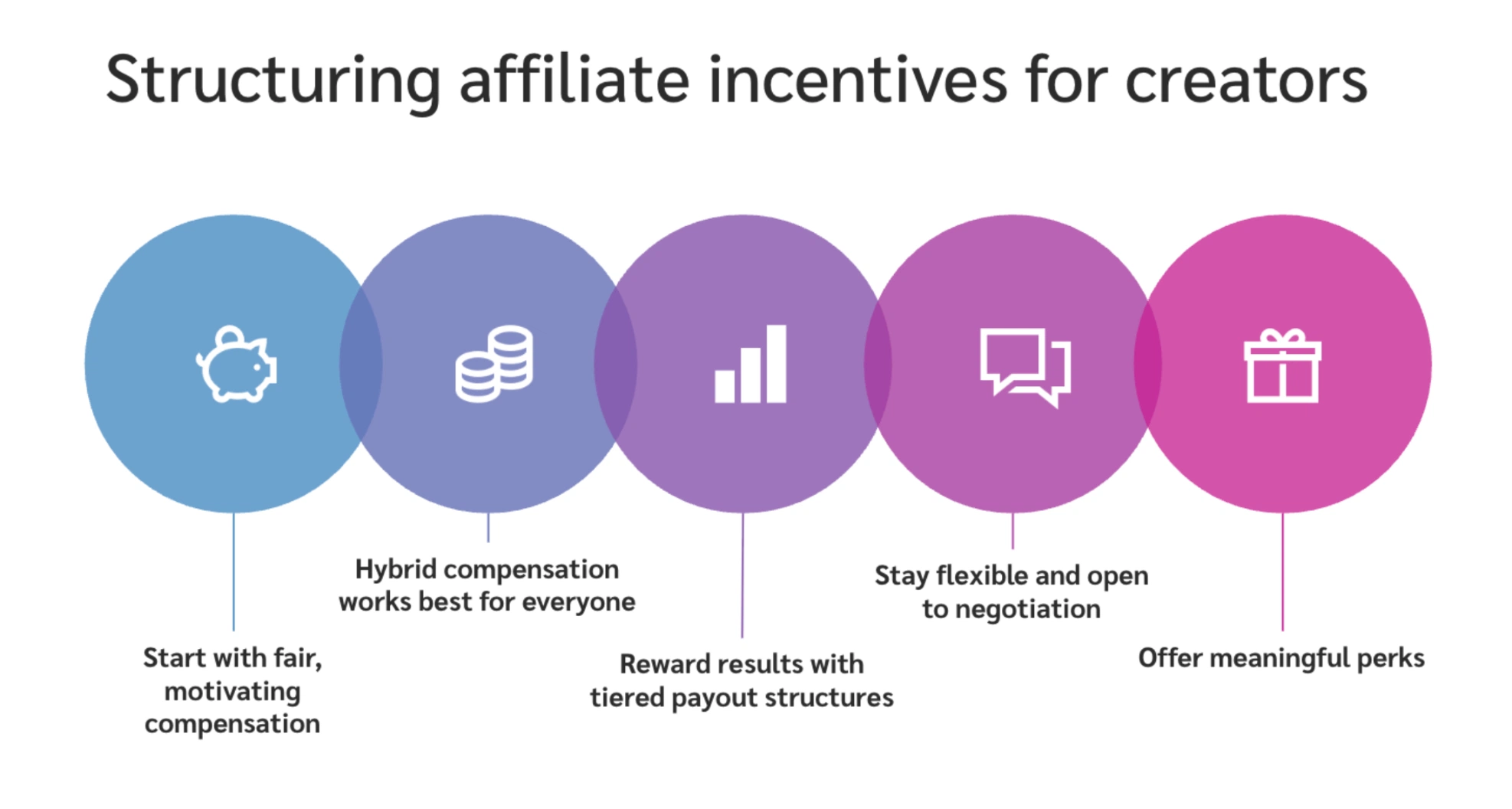
Start with fair, motivating compensation
Paying creators well is essential for long-term partnerships. Pair a fair flat fee with strong commission to reward both the work and the results. Quality content takes time, creativity, and often a team, so payment should reflect that. Keeping pay consistent across campaigns also builds trust and helps prevent churn.
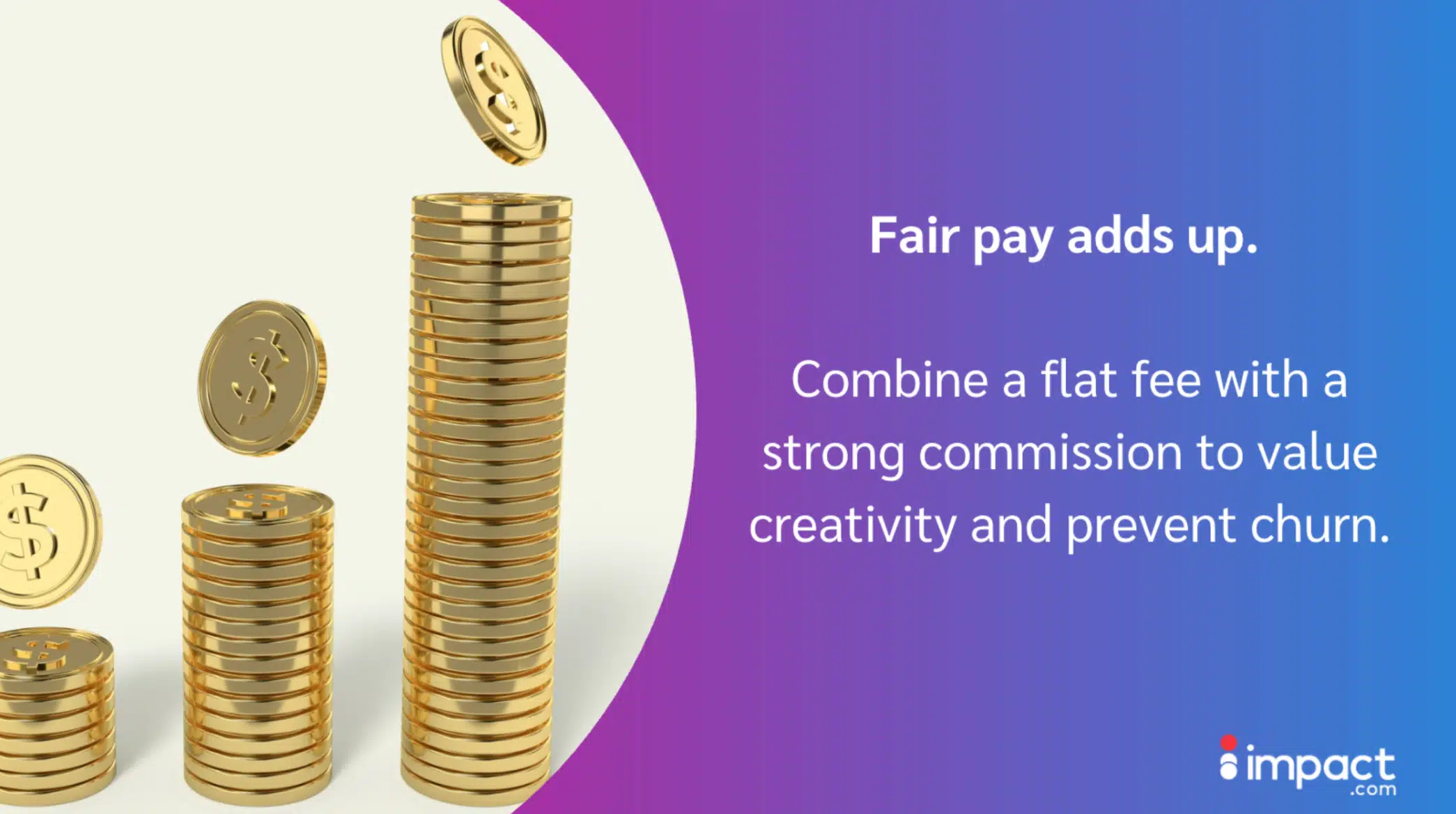
Hybrid compensation works best
Research shows that creators prefer hybrid payout structures, especially when starting new partnerships. A flat fee provides guaranteed income, while commission unlocks scalable earning potential.
Reward results with tiered payout structures
Tiered payout structures can incentivize high performance.
Top performers can earn a higher flat fee, better commission rates, or additional perks. These perks include storefronts and competitive content usage rights.
Stay flexible and open to negotiation
Flexibility can be a powerful bargaining tool when negotiating with creators. Striking the right balance between flat fees and commissions—such as reducing the upfront payment while increasing the commission—can make partnerships significantly more attractive to creators.
Creators naturally gravitate toward deals that maximize their earnings, and brands that can adapt to these preferences are far more likely to secure and keep top talent.
Brands that fail to adapt risk losing top creators to more competitive offers.
Offer meaningful perks
Incentives like early product access, milestone bonuses, or exclusive affiliate codes can further motivate creators and strengthen relationships.
Pro tip: Personalized tracking links and affiliate codes make it easy for creators to promote and for brands to track performance creating a user-friendly experience on both sides.
Real-world affiliate program success stories
When creator partnerships are done right, the results speak for themselves.
These brands used impact.com to build performance-driven programs that scale across affiliates and content partners. The following examples prove that following the right strategy can drive serious ROI.
Merry People expands globally and doubles revenue through diversified partnerships
Australia’s beloved gumboot brand, Merry People, achieved remarkable global growth by combining creators and affiliate partners in a targeted, multi-channel approach.
Challenge: Merry People wanted to expand beyond Australia and build credibility in the U.S. and UK. They needed a diverse partnership strategy spanning creators, niche publishers, and broader affiliates without overextending their team.
Solution: Using impact.com’s automation and analytics platform, Merry People launched a data-driven partnership program. They tested and optimized various partners in real time, tapping into:
- Niche creators and communities, such as gardening and dog-owner influencers, aligned with their core 25–45 demographic
- Mid-tier publishers (e.g., New York Times, Time Inc.), for credibility and mass reach
- Cashback and loyalty platforms, which later drove approximately 35 percent of total partnership revenue
Results:
- Onboarded 334 active partners
- Expanded audience reach across Australia, the U.S., and the UK
- Doubled partnership revenue year-over-year
- Achieved a 25 percent stronger return on ad spend (ROAS)
Why it worked:
- Built authentic trust through niche creators
- Balanced scale with top-tier publisher authority
- Used real-time performance data for agile optimization
- Embraced both creators and traditional affiliate tools, unlocking complementary revenue streams
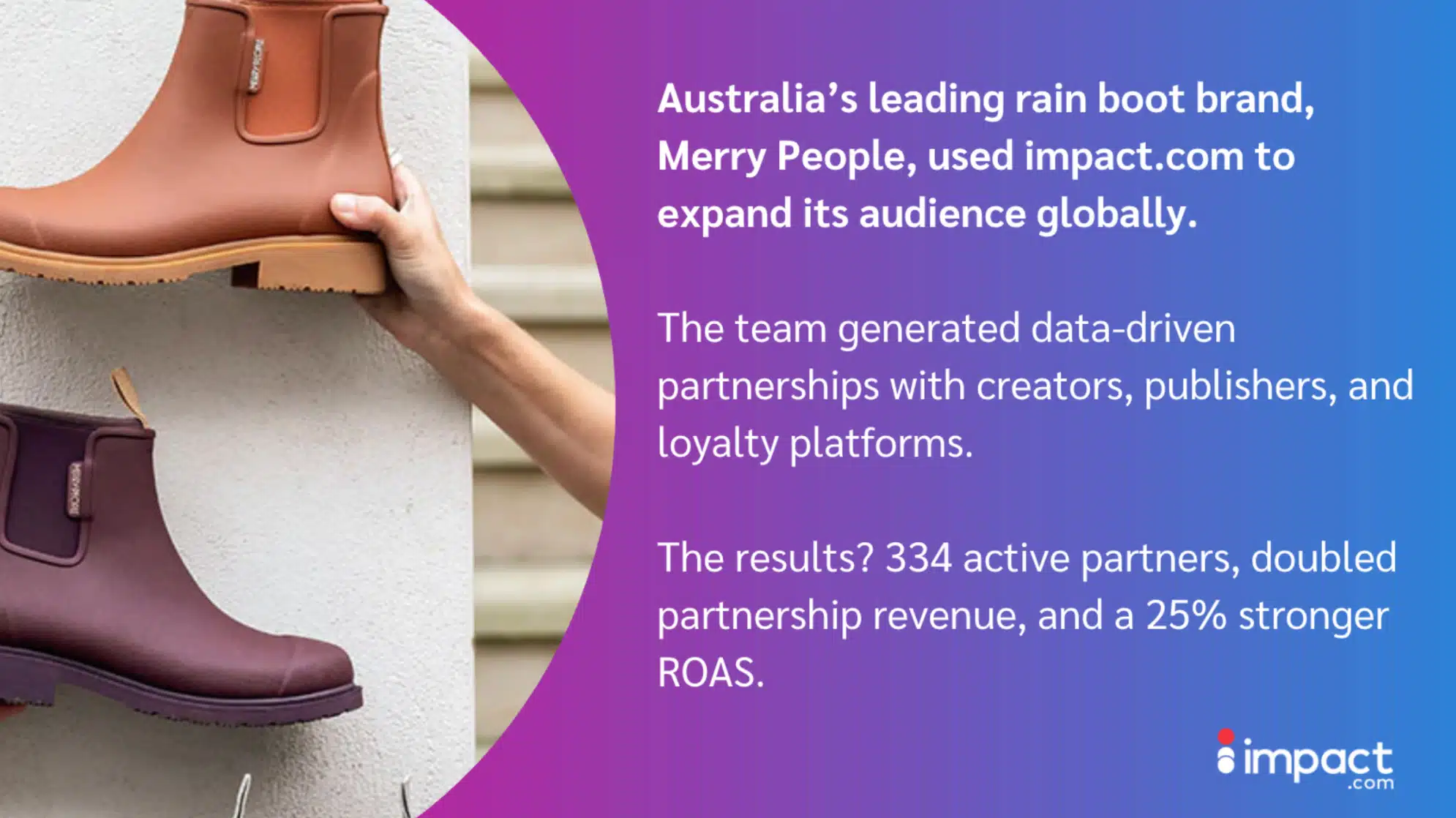
IG Group relaunches partnership program with a mix of creators and affiliates
IG Group, a global online trading provider, optimized its affiliate and influencer ecosystem by partnering with affiliate marketing agency Silverbean. They adopted impact.com’s platform to streamline operations and supercharge performance.
Challenge: IG Group needed a scalable and efficient way to manage diverse partnerships across affiliates, influencers, and B2B collaborations. Their existing processes were manually intensive, sapping internal resources and limiting growth.
Solution: Using impact.com’s automated tools and Silverbean’s strategic oversight, IG Group:
- Launched workshops in London and Frankfurt for unified planning
- Migrated top affiliates onto a robust platform with improved discovery, recruitment, and compliance tools
- Optimized influencer outreach using lookalike search and monitoring features
- Amplified creator-generated content via paid media for expanded reach
Results:
- 74 percent reduction in global affiliate management time
- Internal admin dropped from 7.4 days to 1.9 days per month,
- This saved the equivalent of 96 working days per month
- 128 percent increase in productive affiliate partners and a 146 percent decrease in dormant partners
- 223 percent uplift in ROI for partnership channels
Why it worked:
- Operational efficiency via automation and streamlined processes
- Full-funnel partner strategy, from affiliate to influencer to paid media
- Data-driven optimization of performance and compliance
- Strategic mix of niche influencers and traditional affiliates, unlocking efficiency and scale
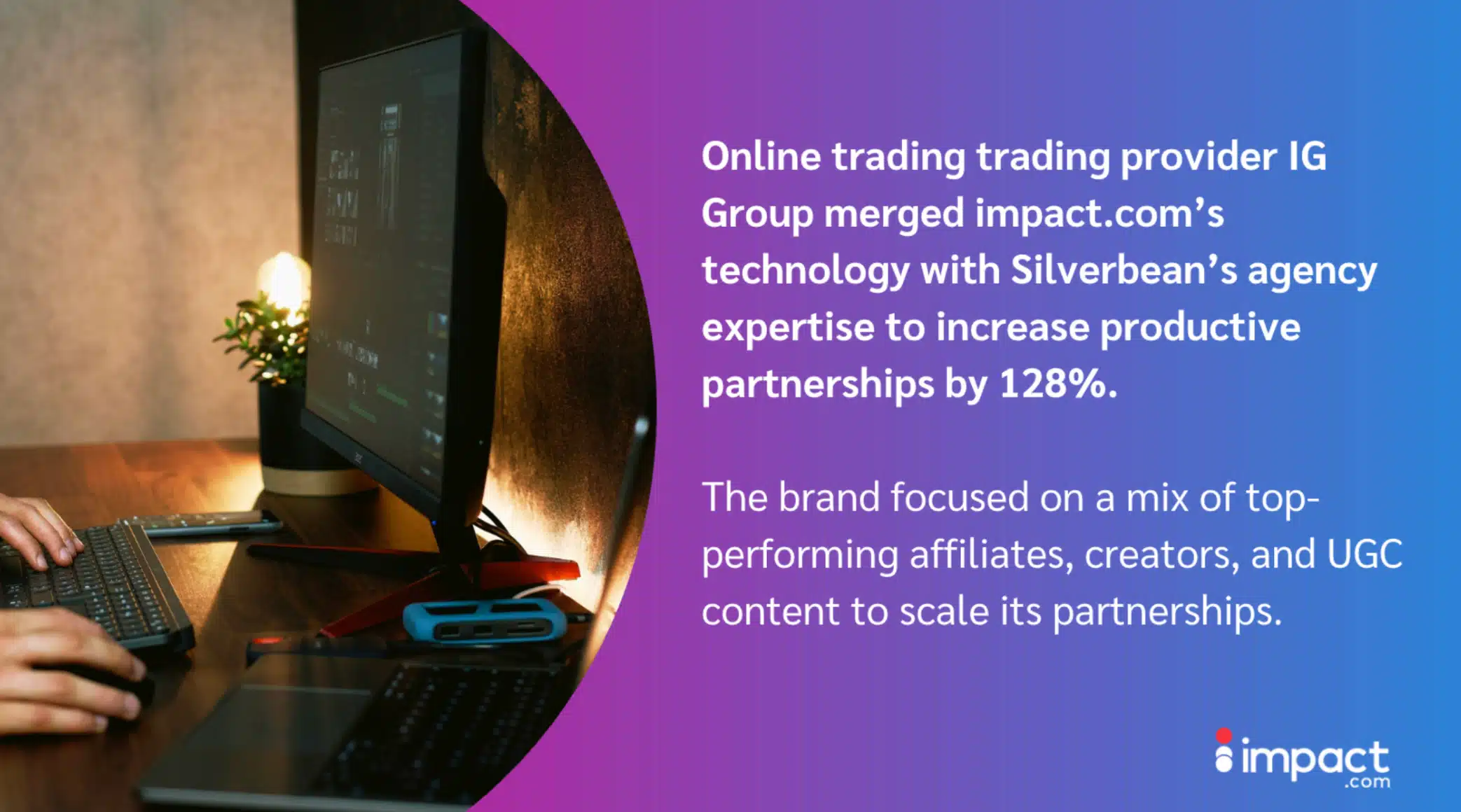
Affiliate disclosure requirements for brands
Brands are accountable when running affiliate campaigns with creators. Ensuring creators follow disclosure rules isn’t optional. It’s a legal and ethical must. It protects both sides and builds trust with audiences.
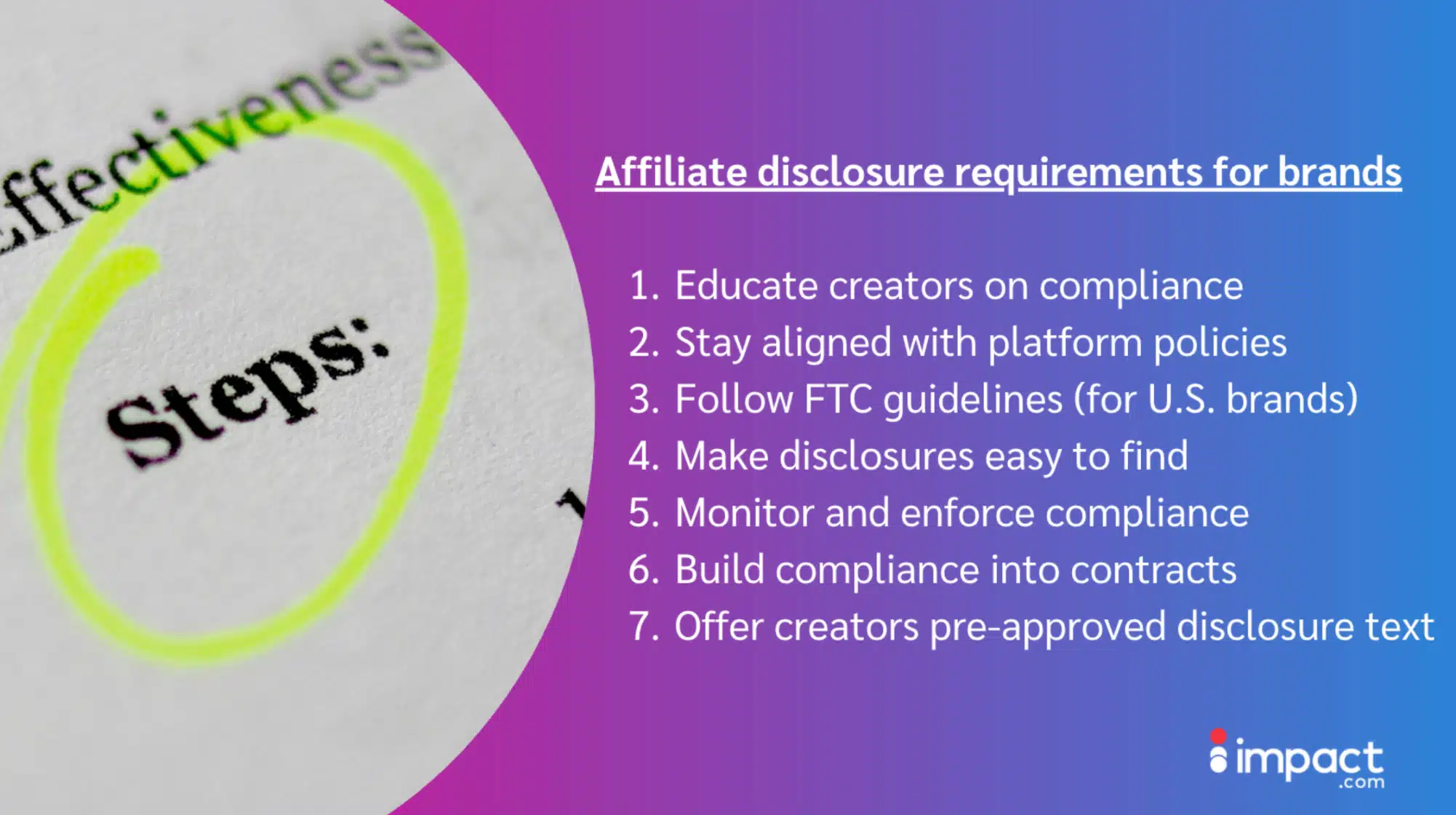
Educate creators on compliance
Brands should proactively guide creators on when and how to disclose affiliate partnerships. To avoid ambiguity, provide easy-to-follow instructions and examples.
Stay aligned with platform policies
Every platform has its own disclosure tools and expectations. Whether it’s Instagram’s “Paid partnership” label or TikTok’s branded content toggle, ensure creators use them correctly and consistently.
Follow FTC guidelines (for U.S. brands)
For US-based campaigns, brands must ensure compliance with FTC rules. Creators must share any material connection, such as payment, affiliate links, or free products.
Make disclosures easy to find
Disclosures should never be buried in a wall of hashtags or require users to click “more.” The FTC expects them to be upfront at the start of captions, verbally in videos, or visually on screen.
Monitor and enforce compliance
Review creator content regularly to ensure proper disclosures are in place. If issues arise, act swiftly to address them. Ongoing oversight is key to avoiding regulatory risk.
Build it into contracts
Include detailed disclosure requirements and the consequences of non-compliance in your creator agreements. This will add legal protection and set clear expectations.
Simplify disclosures with pre-approved captions
Give creators pre-approved disclosure text.
Use phrases like:
- “#Ad”
- “Affiliate link included”
- “I earn a commission if you purchase through this link.”
Remember to provide platform-specific guidance to creators.
In this Instagram Reel for trading platform Pepperstone, creator @ginellesequitin adds a clear #AD tag in the caption and ads disclosures like “All trading involves risk”. She also gives a straightforward look at the product’s features and risks. This reinforces the importance of visible, compliant disclosure. Clarity helps build trust while meeting regulatory expectations.
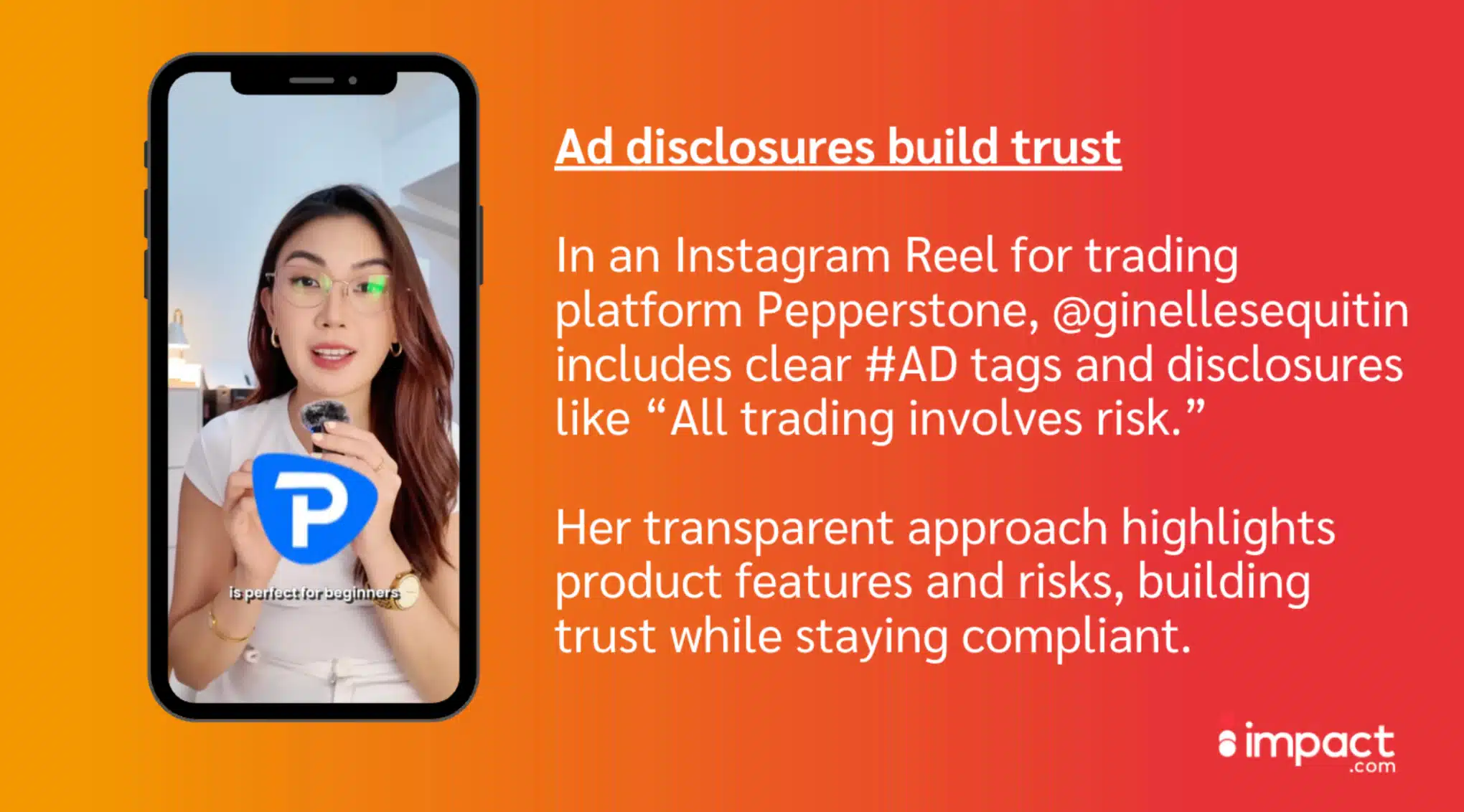
Social commerce in 2025 and beyond: Using integrated platform tools for affiliate creators
Social commerce is changing quickly, with creators leading the way. Platforms are adding more in-app tools. This reduces friction and makes conversions easier. Now, fun content can turn into instant shopping experiences.
Here’s how top platforms ease affiliate sales:
- Instagram Shopping: Creators can tag products in Reels, Stories, and posts. Followers can buy directly in the app.
- TikTok Shop: In-app affiliate features link viral videos to product listings. This allows quick, creator-driven purchases without leaving the feed.
- Pinterest: Idea Pins and affiliate links offer users curated shopping experiences. This helps those seeking inspiration and products.
Look beyond the usual suspects
New platforms are opening fresh opportunities for creator partnerships. LinkedIn is gaining momentum, particularly for B2B brands working with thought leaders and niche experts to build intent and awareness. Pinterest is also on the rise, with shoppable content becoming an increasingly powerful driver for lifestyle and home audiences.
Expect deeper convergence of entertainment and commerce
Imagine a future where product discovery is woven into everyday media. You could pause a TV show, click on a character’s outfit, and be just one tap away from buying it. As the line between content and commerce continues to blur, brands that equip creators with the right affiliate tools will be best positioned to ride the next wave of social commerce.
As platforms blur the line between content and commerce, brands that empower creators with the right affiliate tools will be poised to lead the next wave of social commerce.
Experiment with formats that blend affiliate content and commerce
Affiliate marketing isn’t limited to swipe-up links or static discount codes. Today’s most effective creators blend storytelling, entertainment, and commerce creatively.
Here are four high-impact formats to test:
1. Host live shopping events
Creators can demo products, answer questions in real time, and share affiliate codes during the session driving instant engagement and purchases.
For example, a beauty influencer might walk through their skincare routine live, dropping affiliate links for each product as they go.
2. Share short-form product highlights
Quick, punchy Reels or TikToks capture attention and drive conversions when paired with affiliate links.
Dr. Dray, a dermatologist and content creator, shares quick and insightful TikTok videos reviewing the latest skincare products. She gives honest feedback on what works and what doesn’t. In this TikTok post, she teams up with Neutrogena to highlight their acne patches. She shows how easy they are to use and explains their benefits, all in just 20 seconds.
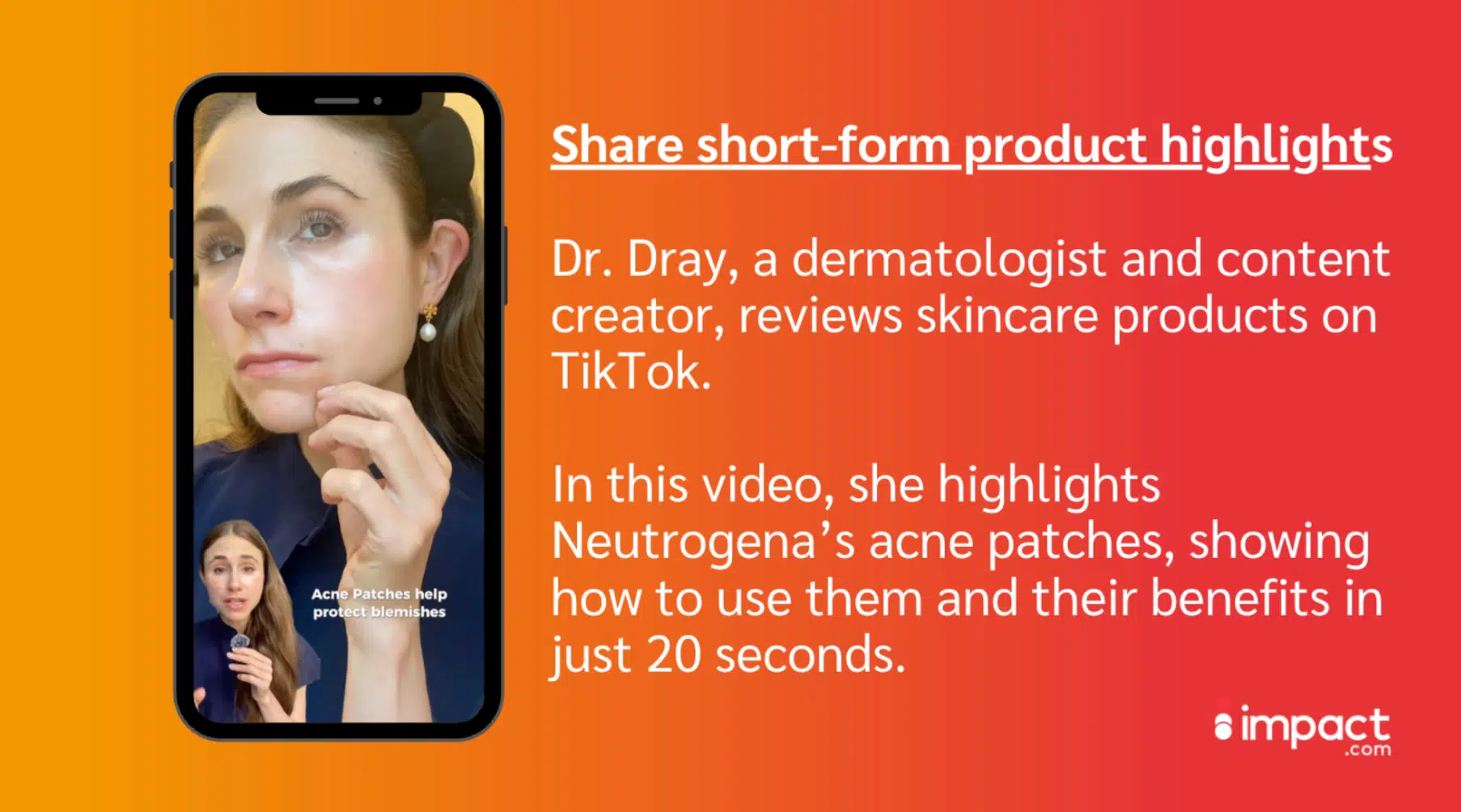
3. Layer product recommendations into educational content
Answering common audience questions creates a natural opening to suggest affiliate-linked solutions.
Content creator @mrbarrylewis, a kitchenware review channel with over one million YouTube subscribers, excels at in-depth gadget breakdowns and retro tech reviews. In a recent video testing the Ninja Creami ice cream maker, he shares real-time demos and personal insights. He drops an Amazon affiliate link in the description.

4. Use passive product placement and automation
Not every affiliate post needs a direct call to action. Passive product placement can drive meaningful revenue. This is especially effective when combined with tools like Link DM, which automatically sends affiliate links to users who comment on a post.
Blending utility, entertainment, and subtle calls to action keeps content engaging and conversion-friendly.
Tracking affiliate campaign performance and optimizing results
The most successful affiliate programs aren’t set-it-and-forget-it. They’re optimized continuously based on performance.
To drive long-term results, brands should treat affiliate campaigns like any other growth channel: data-first and creator-informed.
Track the right metrics
Focus on key indicators like:
- Conversion rates
- Click-through rates (CTR)
- Revenue per affiliate link
- Attribution by creator or platform
Refine content with performance insights
Use these insights to adjust messaging, creative formats, or even audience targeting. Tailor campaigns to match a creator’s specific audience, and you may achieve better engagement and stronger ROI.
Double down on what works
Focus your budget on top-performing creators and be ready to shift resources away from content that’s not delivering.
The real value comes from understanding why certain creators outperform others, and that insight often comes from the creators themselves. Involving them in the feedback loop turns performance data into a collaborative strategy, helping you refine campaigns and scale what works.
Brand tip: Involve creators in the feedback loop.
Affiliate success is iterative. With the right tracking tools and willingness to optimize, brands can continuously improve results and maximize revenue over time.
Overcoming challenges in affiliate-driven social commerce campaigns
Even the most promising affiliate strategies can hit snags without the right structure and support. Let’s talk about common issues (and solutions) in social commerce. From low engagement to unclear tracking and audience mismatches, these tips will help set your campaigns up for success.
Low engagement with affiliate promotions
A common problem brands face is low creator engagement. They often see poor results from affiliate content. Often, the issue isn’t the product, it’s the structure of the partnership.
Solution
Offer better incentives and more creative freedom
Higher commission rates, exclusive discount codes, and flexible content guidelines can boost creator buy-in and motivation. When creators feel empowered and fairly compensated, their content is more authentic and more likely to convert.
Adopt a long-term mindset
Quick wins are rare in affiliate-driven campaigns. Try to invest in the long-term for a minimum of a year. Open the door, let people audition. Building trust takes time, but long-term relationships deliver stronger results.
Coach creators to build their sales skills
Affiliate success requires a slightly different skillset, more persuasive, intentional, and performance-driven. Aim to support creators with:
- Feedback
- Coaching
- Online workshops
Reviewing top-performing content together helps creators refine their strategy and boost results over time.
Difficulty tracking results
Tracking affiliate performance can get messy. Especially when campaigns span multiple platforms, creators, and content formats. Without clear attribution, it’s tough to know what’s actually driving conversions.
Solution
Rely on advanced tracking tools and align on key metrics
Start by using platforms that offer granular tracking for individual affiliate links, clicks, and conversions. You’ll get visibility into what’s working and where to double down.
But tech alone isn’t enough. Direct communication with creators is just as important. Make sure they understand how success is measured and what they’re working toward.
Whether it’s conversions, revenue, or average order value, alignment keeps everyone focused and improves campaign performance across the board.
Misaligned creator audiences
Even great content won’t drive results if it’s reaching the wrong audience. A common mistake in affiliate campaigns is when a creator’s followers don’t match the brand’s target customers.
Solution
Vet creators carefully and match them to the right funnel stage
Don’t just look at follower count. Dig into who’s engaging, where they’re located, and what they care about. A strong audience overlap is key to both awareness and conversion success.
Understand a creator’s natural strengths
Most creators natively are kind of either top of funnel or bottom of funnel. Expecting one creator to drive both awareness (flat fee) and conversions (commission) can lead to poor results and misaligned incentives.
Instead, match creators to the part of the funnel where they shine and compensate them accordingly. That way, you set them up for success and maximize ROI at every stage of the customer journey.
The future of creators in affiliate-driven social commerce
Creator-led affiliate marketing is no longer a fringe tactic. It’s now the foundation of modern social commerce. Brands that adapt early to changing platforms and consumer behaviour will have the advantage.
Here are key trends shaping what’s next:
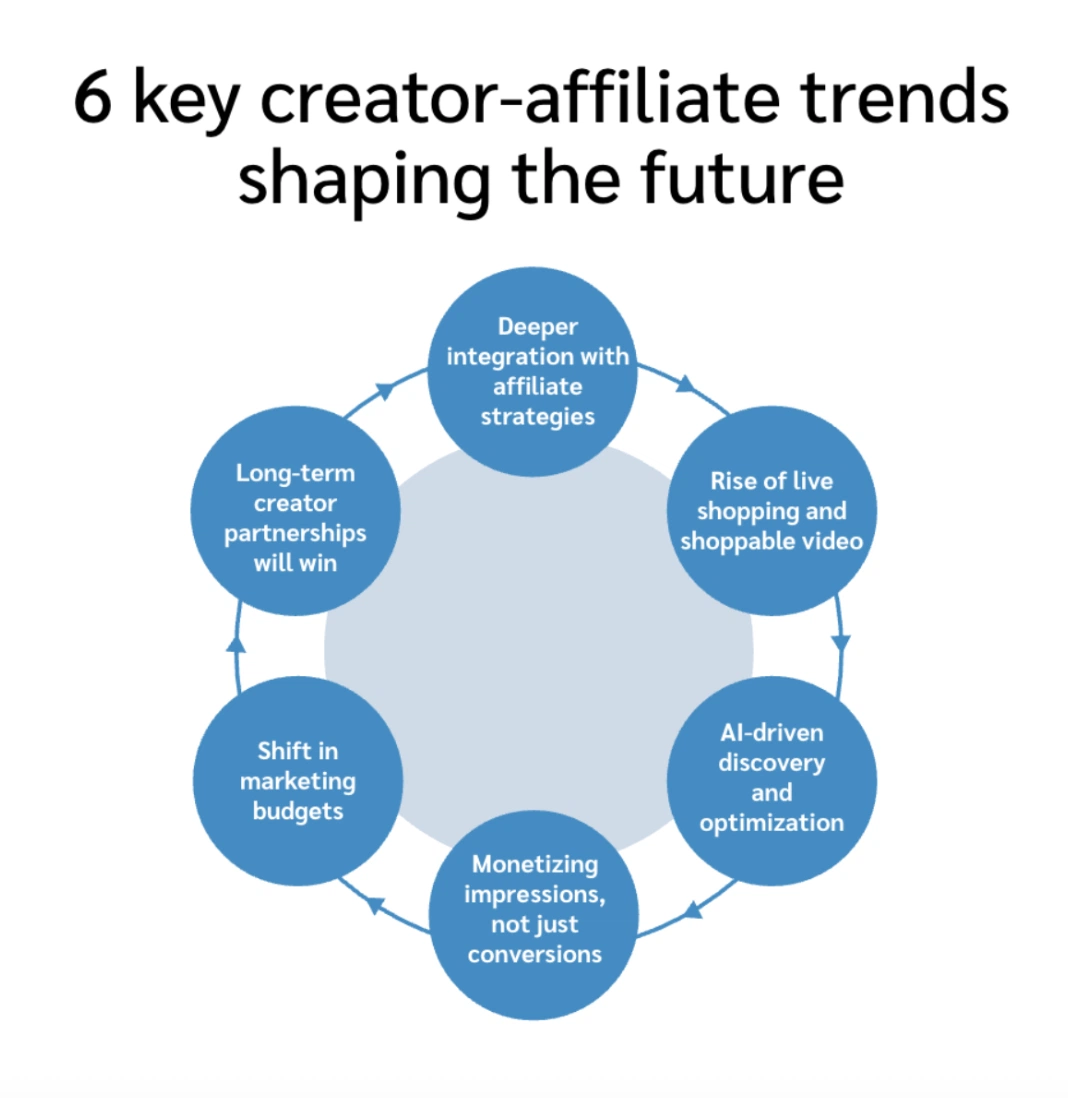
Deeper integration with affiliate strategies
The line between influencer marketing and affiliate marketing is blurring. Expect more hybrid campaigns where creators are both storytellers and performance drivers, equipped with tools that track impact and reward results.
Rise of live shopping and shoppable video
Formats like livestream shopping and interactive video are growing quickly. They give creators exciting ways to show products and connect with audiences in real time.
AI-driven discovery and optimization
AI is reshaping both sides of the affiliate equation, how brands identify the right creators and how consumers find products. For younger audiences, product searches are increasingly starting on social platforms rather than traditional search engines. Discovery now happens in more visual, community-driven spaces.
Meanwhile, Google’s AI-powered search delivers answers directly on the results page, changing how affiliate traffic flows and forcing brands to adapt their strategies for visibility and conversion.
Monetizing impressions, not just conversions
A growing trend in affiliate marketing is compensating creators for the visibility they generate, not just the sales they close. Paying based on CPM (cost per thousand impressions) recognizes the value of awareness, influence, and top-of-funnel reach. It’s a way of rewarding creators whose content drives interest even before a purchase is made.
Shift in marketing budgets
Marketing budgets are steadily shifting away from traditional channels like TV, SEO, and print. More investment is flowing into creator affiliate strategies. Unlike legacy media, these partnerships offer trackable, scalable ROI. So they’re an increasingly attractive choice for brands focused on measurable growth.
Long-term creator partnerships will win
Partnering with creators early in their journey can pay off for years to come. As they grow their audience and influence, your brand benefits from the expanded reach and deepened trust they’ve built with their followers. The key is to identify creator affiliates who consistently deliver results, then invest in the relationship so you can scale together as their careers progress.
FAQs
Content creators play a vital role in driving conversions. They mix shopping with social platforms like Instagram, TikTok, and Pinterest.
Creators build trust with their audience through genuine engagement and real product experiences. This trust boosts buyer intent.
Creators help consumers find and buy products by blending real content with affiliate marketing. They use affiliate links and shoppable content. This creates smooth buying experiences in the app and boosts conversion rates.
Affiliate marketers have several social commerce tools to boost conversions. Instagram Shopping lets creators tag products in their posts for quick purchases.
TikTok has in-app affiliate features. These connect affiliate links to viral videos, so buying is easier.
Additionally, Pinterest provides curated shopping through Idea Pins and supports various affiliate strategies. These platforms enable easy, one-click shopping and include performance tracking for valuable insights.
To succeed in affiliate-driven social commerce campaigns, brands should closely track key metrics.
Key metrics are:
- Conversion rates
- Click-through rates (CTR)
- Total revenue from affiliate links and codes.
These insights help improve campaigns and tailor content for specific audiences.
Brands can encourage creators by providing fair pay, such as flat fees and appealing commission rates.
Offering tiered payouts can reward top creators with better incentives and special opportunities.
Flexible payment models and open negotiations are key to attract and retain top talent. Building long-term relationships means valuing consistent creators. It’s about fostering genuine partnerships and seeing them as entrepreneurial collaborators.
The future for creators in affiliate-driven social commerce is changing quickly. Live-stream shopping and shoppable videos will help creators connect with their audiences. They can also boost quick purchases.
Advancements in AI will make performance tracking easier. It will also help brands the right creators faster.
Maximize ROI through creators and social commerce with affiliate programs
The future of affiliate marketing is here, and it’s driven by meaningful creator partnerships and performance-driven strategies that meet consumers where they are: on social media.
To boost affiliate ROI, brands must move beyond one-off posts and static links.
Key takeaways for success:
- Partner authentically: Work with creators who genuinely align with your brand.
- Empower partners with data-driven feedback: Offer the right tools and incentives to empower creators to perform.
- Full-funnel focus: Build affiliate campaigns that span the entire customer journey, from curiosity to conversion.
- Transparent tracking: Prioritize transparent tracking and ongoing optimization to scale smarter.
- Build true partners: Treat creators as true partners, not just promoters, for long-term growth.
By focusing on these strategies, you’ll lay the foundation for high-impact growth and measurable results.
Check out more content here:
- Scaling influencer marketing campaigns globally [ebook]
- How to pay content creators in 2025: 7 proven payment methods that drive results [blog]
- Affiliate marketing: How to give your businesses the strategic edge [ebook]
- Exploring the Business Side of TikTok with Vana Han, Global Partnerships (SMB) at TikTok [podcast]
- How brands can drive more results with creator campaigns [webinar]
- Evaluating influencer performance in 2025: 3 ways brands can optimize ROI through real-time tracking [blog]
